Influence of a Better Prediction of Thermal Satisfaction for the Implementation of an HVAC-Based Demand Response Strategy
Abstract
:1. Introduction
2. Data Description
3. Limitations of the Conventional TSV Model
- (a)
- OPD: Observational thermal dissatisfaction (percentage of occupants voting for a thermal sensation of cold, cool, warm, or hot for each data bin divided into 0.5 °C OT intervals).
- (b)
- PPD: Percentage of dissatisfied occupants calculated using Fanger’s PMV–PPD equation.
- (c)
4. Results
4.1. Model-Predicted Thermal Sensation
| Algorithm 1. Pseudocode for deterministically establishing the response probability for each TSV category. |
| mean TSV = −6.5368 + 0.3011 × OT (based on the blue line in Figure 1). |
| If mean TSV < −2.5 then “thermal sensation of cold” |
| elseif mean TSV < −1.5 then “thermal sensation of cool” |
| elseif mean TSV < −0.5 then “thermal sensation of slightly cool” |
| elseif mean TSV < 0.5 then “thermal sensation of neutral” |
| elseif mean TSV < 1.5 then “thermal sensation of slightly warm” |
| elseif mean TSV < 2.5 then “thermal sensation of warm” |
| elseif “thermal sensation of hot” |
| end |
4.2. Model-Predicted Thermal Dissatisfaction
4.3. Impact on the Implementation of the HVAC-Based Demand Response Strategy
5. Discussion
6. Conclusions
Author Contributions
Funding
Data Availability Statement
Conflicts of Interest
References
- ASHRAE. ASHRAE Handbook: Fundamentals; ASHRAE: Atlanta, GA, USA, 2013. [Google Scholar]
- de Dear, R.J.; Brager, G.S. Thermal Comfort in Naturally Ventilated Buildings: Revisions to ASHRAE Standard 55. Energy Build. 2002, 34, 549–561. [Google Scholar] [CrossRef] [Green Version]
- ASHRAE. ASHRAE Standard 55—Thermal Environmental Conditions for Human Occupancy; ASHRAE: Atlanta, GA, USA, 2017. [Google Scholar]
- Guo, H.; Qiao, W.; Liu, J. Dynamic Feedback Analysis of Influencing Factors of Existing Building Energy-Saving Renovation Market Based on System Dynamics in China. Sustainability 2019, 11, 273. [Google Scholar] [CrossRef] [Green Version]
- Hoyo-Montaño, J.; Valencia-Palomo, G.; Galaz-Bustamante, R.; García-Barrientos, A.; Espejel-Blanco, D. Environmental Impacts of Energy Saving Actions in an Academic Building. Sustainability 2019, 11, 989. [Google Scholar] [CrossRef] [Green Version]
- Goldman, C.; Hopper, N.; Sezgen, O.; Moezzi, M.; Bharvirkar, R. Does Real-Time Pricing Deliver Demand Response? A Case Study of Niagara Mohawk’s Large Customer RTP Tariff. In Proceedings of the ACEEE 2004 Summer Study on Energy Efficiency in Buildings; 2004. Available online: https://www.aceee.org/files/proceedings/2004/data/papers/SS04_Panel5_Paper10.pdf (accessed on 20 April 2022).
- Watson, D.S.; Kiliccote, S.; Motegi, N.; Piette, M.A. Strategies for Demand Response in Commercial Buildings. In Proceedings of the ACEEE Summer Study on Energy Efficiency in Buildings, Pacific Grove, CA, USA, 13–18 August 2006. [Google Scholar]
- Lan, L.; Wargocki, P.; Lian, Z. Quantitative Measurement of Productivity Loss Due to Thermal Discomfort. Energy Build. 2011, 43, 1057–1062. [Google Scholar] [CrossRef]
- Jensen, K.L.; Toftum, J.; Friis-Hansen, P. A Bayesian Network Approach to the Evaluation of Building Design and Its Consequences for Employee Performance and Operational Costs. Build. Environ. 2009, 44, 456–462. [Google Scholar] [CrossRef]
- Seppänen, O.; Fisk, W.J.; Lei, Q.H. Room Temperature and Productivity in Office Work; Lawrence Berkeley National Laboratory: Berkeley, CA, USA, 2006; Available online: https://escholarship.org/uc/item/9bw3n707 (accessed on 20 April 2022).
- Adams, J.N.; Bélafi, Z.D.; Horváth, M.; Kocsis, J.B.; Csoknyai, T. How Smart Meter Data Analysis Can Support Understanding the Impact of Occupant Behavior on Building Energy Performance: A Comprehensive Review. Energies 2021, 14, 2502. [Google Scholar] [CrossRef]
- Ali, Q.; Thaheem, M.J.; Ullah, F.; Sepasgozar, S.M.E. The Performance Gap in Energy-Efficient Office Buildings: How the Occupants Can Help? Energies 2020, 13, 1480. [Google Scholar] [CrossRef] [Green Version]
- Homod, R.Z.; Sahari, K.S.M.; Almurib, H.A.F.; Nagi, F.H. Gradient Auto-Tuned Takagi–Sugeno Fuzzy Forward Control of a HVAC System Using Predicted Mean Vote Index. Energy Build. 2012, 49, 254–267. [Google Scholar] [CrossRef]
- Schito, E.; Conti, P.; Urbanucci, L.; Testi, D. Multi-Objective Optimization of HVAC Control in Museum Environment for Artwork Preservation, Visitors’ Thermal Comfort and Energy Efficiency. Build. Environ. 2020, 180, 107018. [Google Scholar] [CrossRef]
- Mary Reena, K.E.; Mathew, A.T.; Jacob, L. A Flexible Control Strategy for Energy and Comfort Aware HVAC in Large Buildings. Build. Environ. 2018, 145, 330–342. [Google Scholar] [CrossRef]
- Turley, C.; Jacoby, M.; Pavlak, G.; Henze, G. Development and Evaluation of Occupancy-Aware HVAC Control for Residential Building Energy Efficiency and Occupant Comfort. Energies 2020, 13, 5396. [Google Scholar] [CrossRef]
- Fanger, P.O. Thermal Comfort, 1st ed.; McGraw-Hill: New York, NY, USA, 1972. [Google Scholar]
- Chen, J.; Augenbroe, G.; Wang, Q.; Song, X. Uncertainty Analysis of Thermal Comfort in a Prototypical Naturally Ventilated Office Building and Its Implications Compared to Deterministic Simulation. Energy Build. 2017, 146, 283–294. [Google Scholar] [CrossRef]
- Benton, C.C.; Bauman, F.S.; Fountain, M.E. A Field Measurement System for the Study of Thermal Comfort. ASHRAE Trans. 1990, 96, 623–633. [Google Scholar]
- Schiller, G.E. A Comparison of Measured and Predicted Comfort in Office Buildings. ASHRAE Trans. 1990, 96, 609–622. [Google Scholar]
- de Paula Xavier, A.A.; Lamberts, R. Indices of Thermal Comfort Developed from Field Survey in Brazil. ASHRAE Trans. 2000, 106, 45–58. [Google Scholar]
- Katić, K.; Li, R.; Zeiler, W. Machine Learning Algorithms Applied to a Prediction of Personal Overall Thermal Comfort Using Skin Temperatures and Occupants’ Heating Behavior. Appl. Ergon. 2020, 85, 103078. [Google Scholar] [CrossRef]
- Ghahramani, A.; Tang, C.; Becerik-Gerber, B. An Online Learning Approach for Quantifying Personalized Thermal Comfort via Adaptive Stochastic Modeling. Build. Environ. 2015, 92, 86–96. [Google Scholar] [CrossRef] [Green Version]
- Li, D.; Menassa, C.C.; Kamat, V.R. Personalized Human Comfort in Indoor Building Environments under Diverse Conditioning Modes. Build. Environ. 2017, 126, 304–317. [Google Scholar] [CrossRef]
- Lim, J.; Choi, W.; Akashi, Y.; Yoshimoto, N.; Ooka, R. Bayesian Prediction Model of Thermally Satisfied Occupants Considering Stochasticity Due to Inter- and Intra-Individual Thermal Sensation Variations. J. Build. Eng. 2022, 52, 104414. [Google Scholar] [CrossRef]
- Földváry Ličina, V.; Cheung, T.; Zhang, H.; de Dear, R.; Parkinson, T.; Arens, E.; Chun, C.; Schiavon, S.; Luo, M.; Brager, G.; et al. Development of the ASHRAE Global Thermal Comfort Database II. Build. Environ. 2018, 142, 502–512. [Google Scholar] [CrossRef] [Green Version]
- Oseland, N.A. Acceptable Temperature Ranges in Naturally Ventilated and Air-Conditioned Offices. ASHRAE Trans. 1998, 104, 1018–1030. [Google Scholar]
- ISO 7730:2005; Ergonomics of the Thermal Environment: Analytical Determination and Interpretation of Thermal Comfort Using Calculation of the PMV and PPD Indices and Local Thermal Comfort Criteria. International Organization for Standardization: Geneva, Switzerland, 2005.
- Majewski, G.; Orman, Ł.J.; Telejko, M.; Radek, N.; Pietraszek, J.; Dudek, A. Assessment of Thermal Comfort in the Intelligent Buildings in View of Providing High Quality Indoor Environment. Energies 2020, 13, 1973. [Google Scholar] [CrossRef]
- Lin, T.-P. Thermal Perception, Adaptation and Attendance in a Public Square in Hot and Humid Regions. Build. Environ. 2009, 44, 2017–2026. [Google Scholar] [CrossRef]
- Hwang, R.-L.; Lin, T.-P. Thermal Comfort Requirements for Occupants of Semi-Outdoor and Outdoor Environments in Hot-Humid Regions. Archit. Sci. Rev. 2007, 50, 357–364. [Google Scholar] [CrossRef]
- Spagnolo, J.; de Dear, R. A Field Study of Thermal Comfort in Outdoor and Semi-Outdoor Environments in Subtropical Sydney Australia. Build. Environ. 2003, 38, 721–738. [Google Scholar] [CrossRef] [Green Version]
- Lim, J.; Akashi, Y.; Yoshimoto, N. Bayesian Inference for Predicting an Inter-Individual Variation of Thermal Sensation Votes. In Proceedings of the Building Simulation 2019: 16th Conference of IBPSA, Rome, Italy, 2–4 September 2019. [Google Scholar]
- Roelofsen, P. The Design of the Work Place as a Strategy for Productivity Enhancement. In Proceedings of the 7th REHVA World Congress (CLIMA 2000), Napoli, Italy, 15–18 September 2001. [Google Scholar]
- Berglund, L.G.; Gonzales, R.R.; Gagge, A.P. Predicted Human Performance Decrement from Thermal Discomfort and ET*. In Proceedings of the Indoor Air ’90, Toronto, ON, Canada, 29 July–3 August 1990. [Google Scholar]

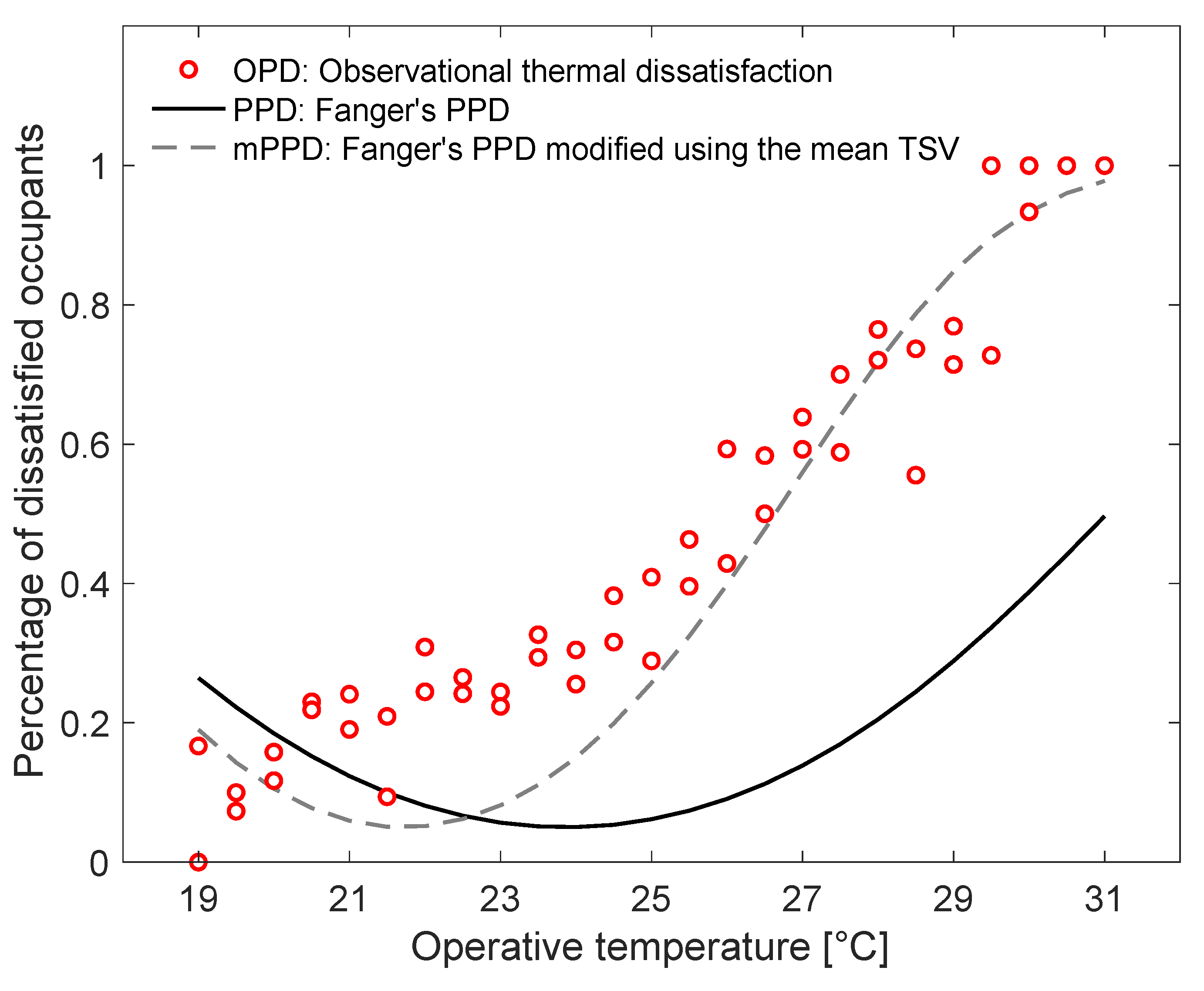
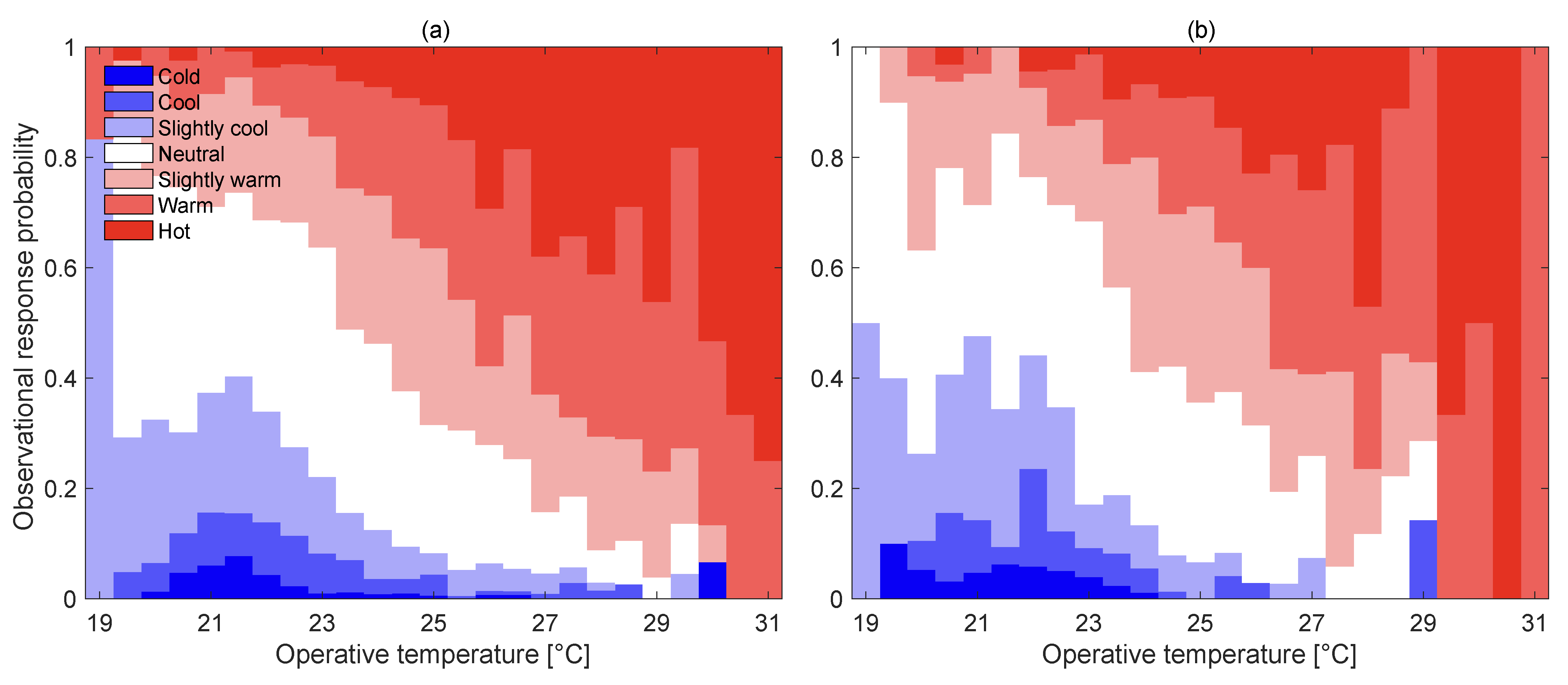
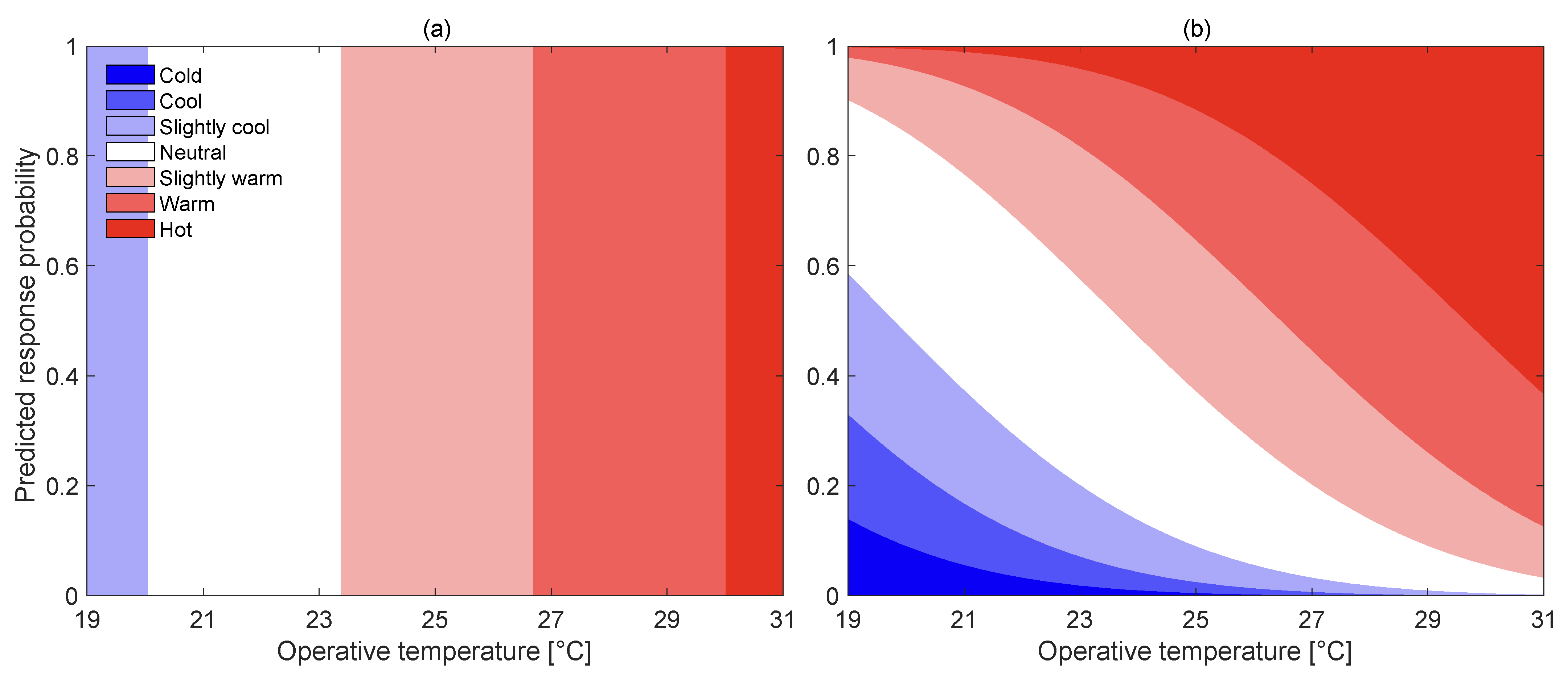
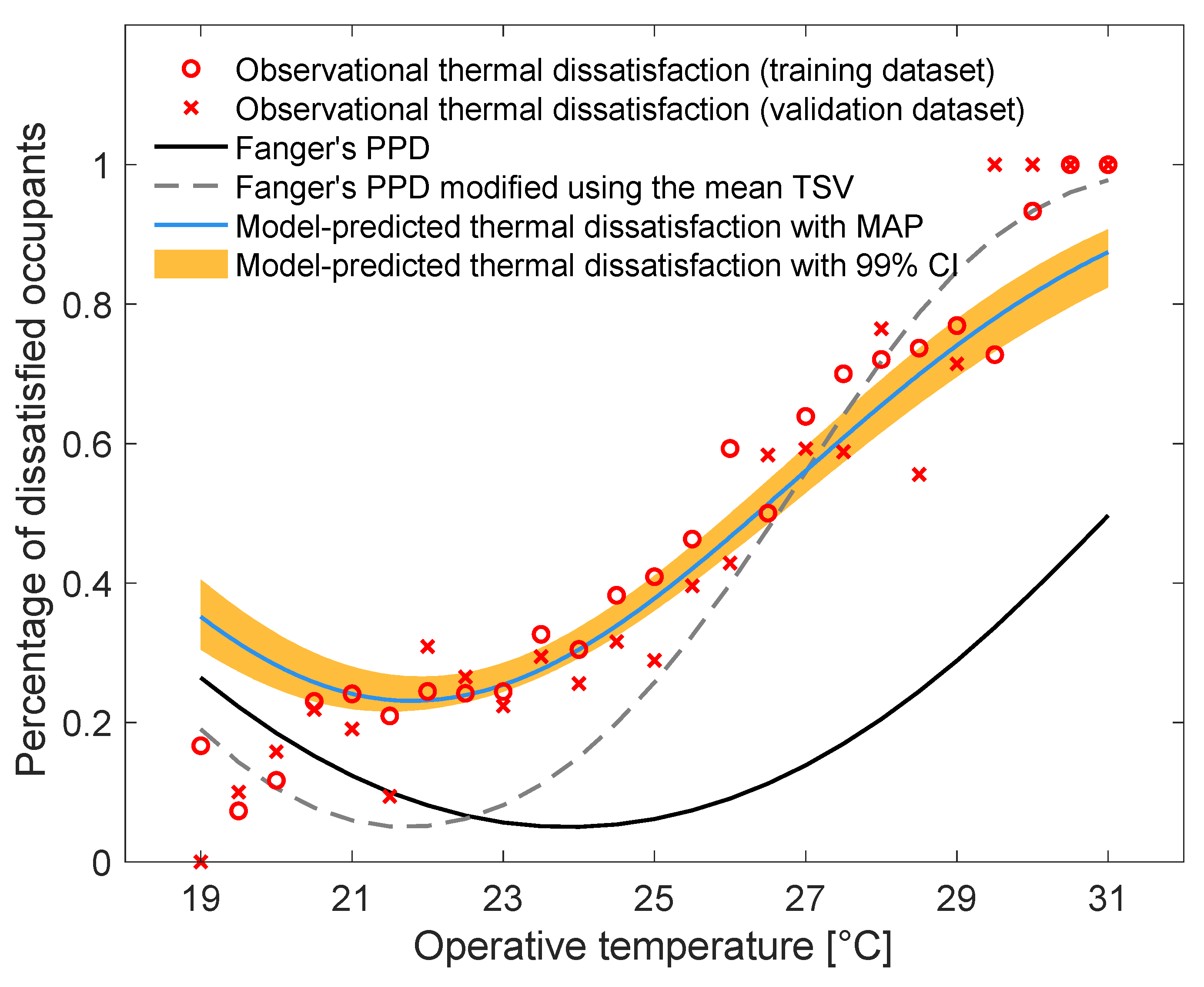
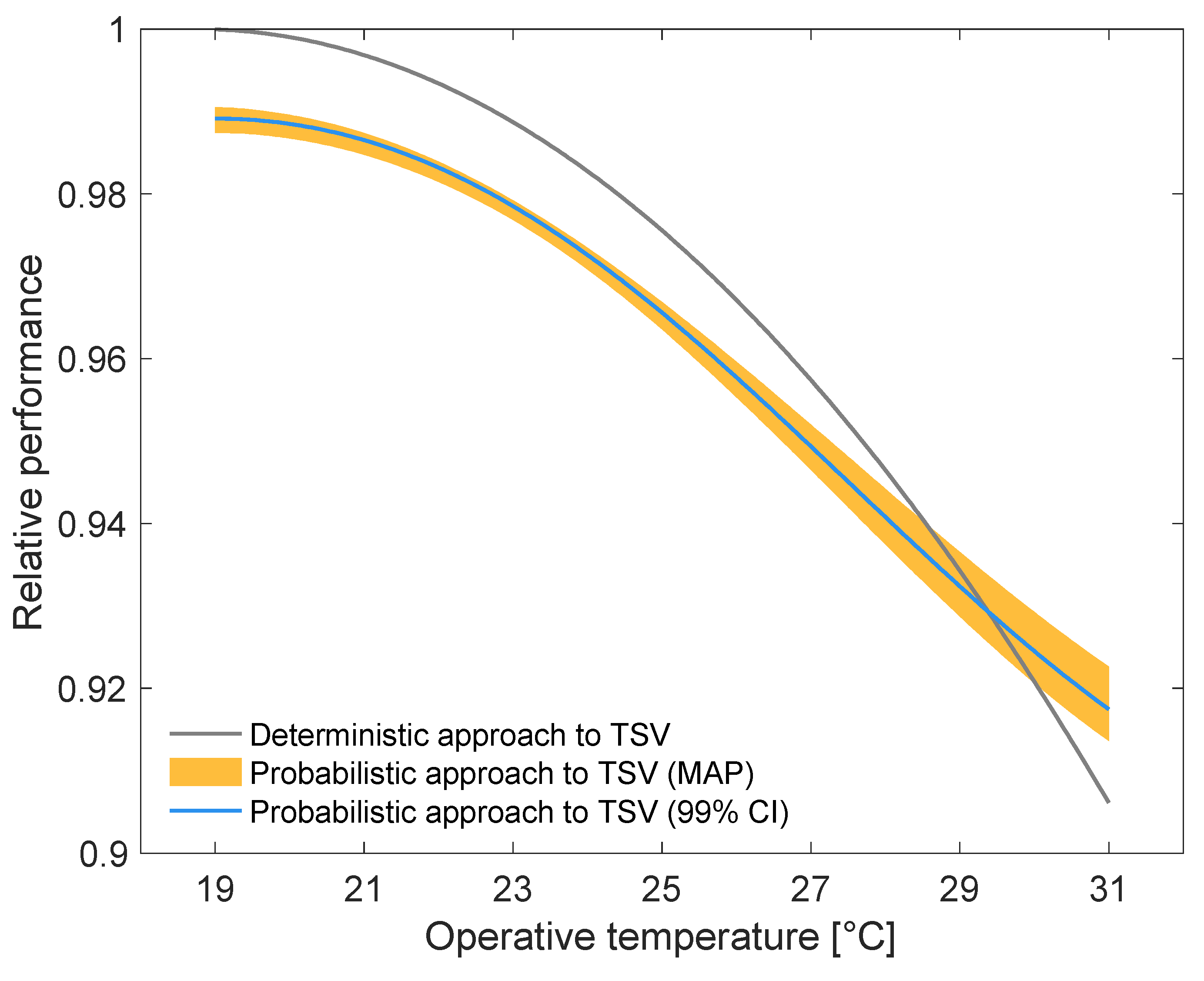
| Variable | Description |
|---|---|
| Thermal sensation vote (TSV) | The seven-point scaled thermal sensation −3: cold, −2: cool, −1: slightly cool, 0: neutral, 1: slightly warm, 2: warm, 3; hot |
| Thermal acceptability | 0: unacceptable, 1: acceptable |
| Clothing insulation [clo] | Intrinsic clothing ensemble insulation of the subject |
| Metabolic rate [met] | Average activity level of the subject |
| Air temperature [°C] | Air temperature 1.1 m above the floor |
| Globe temperature [°C] | Globe temperature 1.1 m above the floor |
| Relative humidity [%] | Relative humidity |
| Air velocity [m/s] | Airspeed 1.1 m above the floor |
| Thermal Sensation | Cold | Cool | Slightly Cool | Neutral | Slightly Warm | Warm | Hot |
|---|---|---|---|---|---|---|---|
| Counts | 46 | 118 | 251 | 561 | 280 | 137 | 39 |
| Share | 3.2% | 8.2% | 17.5% | 39.2% | 19.6% | 9.6% | 2.7% |
Publisher’s Note: MDPI stays neutral with regard to jurisdictional claims in published maps and institutional affiliations. |
© 2022 by the authors. Licensee MDPI, Basel, Switzerland. This article is an open access article distributed under the terms and conditions of the Creative Commons Attribution (CC BY) license (https://creativecommons.org/licenses/by/4.0/).
Share and Cite
Lim, J.; Choi, W. Influence of a Better Prediction of Thermal Satisfaction for the Implementation of an HVAC-Based Demand Response Strategy. Energies 2022, 15, 3094. https://doi.org/10.3390/en15093094
Lim J, Choi W. Influence of a Better Prediction of Thermal Satisfaction for the Implementation of an HVAC-Based Demand Response Strategy. Energies. 2022; 15(9):3094. https://doi.org/10.3390/en15093094
Chicago/Turabian StyleLim, Jongyeon, and Wonjun Choi. 2022. "Influence of a Better Prediction of Thermal Satisfaction for the Implementation of an HVAC-Based Demand Response Strategy" Energies 15, no. 9: 3094. https://doi.org/10.3390/en15093094
APA StyleLim, J., & Choi, W. (2022). Influence of a Better Prediction of Thermal Satisfaction for the Implementation of an HVAC-Based Demand Response Strategy. Energies, 15(9), 3094. https://doi.org/10.3390/en15093094







